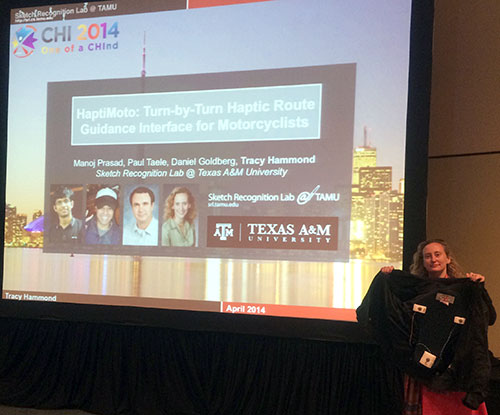 Dr. Tracy A. Hammond, associate professor and director of the Sketch Recognition Lab in the Department of Computer Science and Engineering at Texas A&M University, Dr. Manoj Prasad, and Doctoral Candidate Paul Taele participated in CHI 2014. The ACM Special Interest Group on Computer-Human Interaction (SIGCHI) conference is known as the foremost conference on Human Factors in Computing Systems. CHI 2014 was held at the Metro Toronto Convention Centre in Toronto, Canada, from April 26 to May 1. Publication and presentation in the CHI conference is highly competitive and the most prestigious venue for publications in the field of human computer interaction. Google Scholar reports its h5-index to be 78, and it h5-median to be 114, higher than any other conference or even journals in the field of HCI.
Dr. Tracy A. Hammond, associate professor and director of the Sketch Recognition Lab in the Department of Computer Science and Engineering at Texas A&M University, Dr. Manoj Prasad, and Doctoral Candidate Paul Taele participated in CHI 2014. The ACM Special Interest Group on Computer-Human Interaction (SIGCHI) conference is known as the foremost conference on Human Factors in Computing Systems. CHI 2014 was held at the Metro Toronto Convention Centre in Toronto, Canada, from April 26 to May 1. Publication and presentation in the CHI conference is highly competitive and the most prestigious venue for publications in the field of human computer interaction. Google Scholar reports its h5-index to be 78, and it h5-median to be 114, higher than any other conference or even journals in the field of HCI.
At the conference, Hammond presented the full paper: "HaptiMoto: Turn-by-turn Haptic Route Guidance interface for Motorcyclists," written by Dr. Manoj Prasad, Paul Taele, Dr. Daniel Goldberg (assistant professor of geography at Texas A&M), and Dr. Tracy A. Hammond. This work discusses a vest that provides directions for motorcyclists through touch with the use of vibration tactors in the back of a jacket. Co-author Taele additionally participated in the doctoral consortium at the conference, presenting his work, "Intelligent Sketching Interfaces for Richer Mid-Air Drawing Interactions," on surfaceless sketch recognition.
The abstract for the paper, "HaptiMoto: Turn-by-turn Haptic Route Guidance interface for Motorcyclists," is as follows:
A national study by the Australian Transport Safety Bureau revealed that motorcyclist deaths were nearly thirty times more prevalent than that of drivers of other vehicles. These fatalities represent approximately 5% of all highway deaths each year, yet motorcycles account for only 2% of all registered vehicles in the United States. Motorcyclists are highly exposed on the road, so maintaining situational awareness at all times is crucial. Route guidance systems enable users to efficiently navigate between locations using dynamic visual maps and audio directions, and have been well tested with motorists, but remain unsafe for use by motorcyclists. Audio/visual routing systems decrease motorcyclists' situational awareness and vehicle control, and thus elevate chances of an accident. To enable motorcyclists to take advantage of route guidance while maintaining situational awareness, we created HaptiMoto, a wearable haptic route guidance system. HaptiMoto uses tactile signals to encode the distance and direction of approaching turns, thus avoiding interference with audio/visual awareness. Our evaluations demonstrate that HaptiMoto is both intuitive and a safer alternative for motorcyclists compared to existing solutions.
Hammond joined Texas A&M University in 2006. She holds a doctoral degree in computer science and finance technology option from MIT and four degrees from Columbia University: master degrees in anthropology and computer science, bachelor degrees in mathematics and applied mathematics. Her research focuses on human perception, sketch recognition, computer human interaction, and learning. In 2012 Hammond received the IAAI Innovative Applications of AI Deployed Application Award and was named the Charles H. Barclay Jr. '45 College of Engineering Faculty Fellow.
Prasad graduated this spring with a doctoral degree in computer science. In 2007 he earned a bachelor of engineering degree in computer science from Birla Institute of Technology and Science, India. During his years at Texas A&M he was a member of the Sketch Recognition Lab and a Graduate Teaching Academy Fellow. His research interests are sketch recognition, touch and haptic interfaces.
Taele, also a member of the Sketch Recognition Lab, has bachelor degrees in computer science and mathematics from the University of Texas at Austin and a master of science degree in computer science from Texas A&M. Before beginning his studies at Texas A&M, Paul pursued Chinese Mandarin language studies as a non-degree option at National Chengchi University in Taiwan under a full scholarship awarded by Taiwan's Ministry of Education. His research interests are in sketch recognition, natural user interfaces and interaction design.